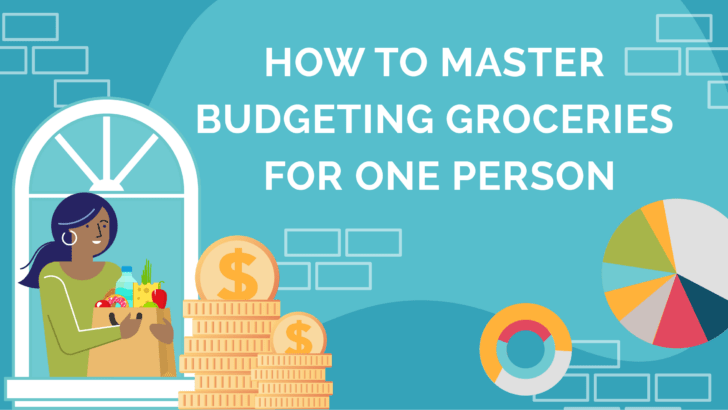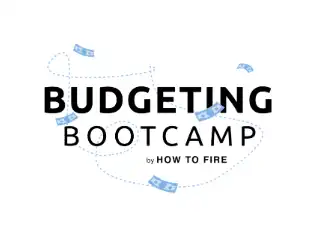You can’t live without food, but you must have a food budget to keep yourself on track. If your grocery bill is constantly too high for your budget, it can be hard to reach your financial goals.
So how does budgeting groceries for one person work?
Check out this simple guide to help lower your average grocery bill and make shopping enjoyable again.
Table of Contents
How Much Does a Single Person Spend on Groceries?
How much a single person spends on groceries depends on many factors, including their age, gender, and lifestyle. But according to the Bureau of Labor Statistics, in 2021, the latest data available, the average grocery bill for 2.4 unit families is $5,259 per year.
Hence, a single-person household spends $182.60 per month. However, accounting for inflation, this number is likely much higher today since food costs have risen.
Budgeting Groceries for One Person: Recommended Food Spending Plans From the USDA
The USDA created recommended food spending levels based on various costs. The Thrifty plan is the most restrictive, and the liberal budget is the most expansive, providing you with options.
- Thrifty Plan – The USDA recommends a monthly grocery budget of $241.40 for females ages 20 – 50 and $301.50 for males.
- Low-Cost – According to the USDA, a low-cost budget is $257 for females ages 19 – 50 and $296.60 for males.
- Moderate Cost – A moderate cost budget for females is $313.60 per month, and for males $371.70.
- Liberal Cost – A liberal food budget for females is $400.80 and for men $451.80.
Of course, these are just suggestions, but they can give you a good starting point if you want to get onto a reasonable food budget.

5 Steps to Budgeting Groceries for One Person
As you can see, there are many methods of budgeting groceries for one person. The USDA guidelines show how much you would need to spend on each budget for a nutritional diet. But to build your personal monthly budget for groceries, try these five steps.
1. Choose a Budgeting Method
Start by choosing a budgeting method. Everyone prefers different methods, and you should use what works for you.
The key to any grocery shopping budget is to leave wiggle room. Food prices continue to increase, so leaving room for unexpected price increases is essential.
50/30/20 Budget
A standard method that works well for budgeting groceries for one person is the 50/30/20 method. This method allows 50% of your income for needs, which includes groceries, 30% for wants, and 20% for savings and debt payoff.
The needs category also includes things like your mortgage or rent, utilities, and insurance payments. To determine how much you could spend on groceries, take 50% of your income and subtract other fixed expenses, like housing, utilities, and insurance.
Also Read: 30/30/30/10 Budgeting Method & 60/30/10 Budgeting Method
Envelope Budget
The envelope budget is another good option to keep grocery spending within reason. The envelope budget uses envelopes, as the name suggests. On each envelope, you write the expense it should cover.
So one envelope would have a grocery budget on it. Be sure to include enough to buy groceries for the week or month, depending on whether you budget weekly or monthly. Stuff the envelope with the cash you budgeted and only spend that amount on groceries.
If you find you always have to go into other envelopes to cover your groceries, it’s time to redo your budget.
Related Article: Best Cash Envelope Wallets
Check Historical Grocery Spending
Look at your past spending to get a good idea of how much to budget for groceries. You can pull bank or credit card statements to see how much you typically spend. With the increasing food prices recently, it’s best to stick to the last month or two of statements.
If you notice you’re spending much more than you budget for groceries, find ways to cut back, whether by shopping sales, using coupons, or switching to store brands.
Take Inventory
Shop your kitchen first! It sounds weird, but many of us are trained to buy more food consistently, but what about what you already have?
Take inventory, writing down everything you have in your fridge, freezer, and panty. When planning meals, you should use this food first and supplement it with other necessary items.
Check Local Sales
After you’ve taken inventory of your food, check the local sales flyers. If you have several grocery stores near you, check as many as possible. Look for food that is on sale that would fit your family’s lifestyle.
Plan Meals
Once you have a good idea of what you have at home and the foods on sale at the grocery store, it’s time to create a weekly menu.
This may seem time-consuming, but it can save you significant money. First, plan meals using what you have. If you need to supplement with a few fresh items, that’s okay, but try sticking with what you have.
Ensure your meal plan covers breakfast, lunch, dinner, and snacks. This limits the number of times you have to run to the store again or that you eat out.
Next, plan meals based on the sales flyers. Consider implementing a meatless day into your week to cut back on spending, or focus only on the items that usually cost you the most that are on sale.
For example, if your family loves chicken and chicken breasts are on sale, center your meal plan around that as your main protein. Grocery stores rotate what they put on sale. If you figure out the grocery store cycle, you’ll get in a groove with your meal planning and can make saving money on groceries look easy.
Make a Grocery List and Shop
Once you’ve created your meal plan, it’s time to shop! But don’t go without a shopping list. The key is to only buy what you planned so you can stick to your grocery budget.
Ideally, you’ll stick to the store’s perimeter, where you find meat, produce, and dairy. Of course, being realistic, everyone has to hit the middle aisles at some point, but again stick to your list and try only to get what’s on sale.
Learn how to track your money in less than 20 minutes with our PROVEN values-based budgeting system!
You deserve less stress and more fun when it comes to managing your money.
How To Save Money by Food Group When Shopping for One Person Meals
Knowing how to save money on groceries by food group can help you save even more.
Produce
To save money on produce, buy what’s in season. For example, you can buy apples for next to nothing during apple season. The same is true of melons and strawberries in the summer. Get the hang of what’s in season and what isn’t, and only buy what’s on sale.
If there are fruits or veggies you love that aren’t in season, buy frozen. They are just as nutritious as the fresh options, will last longer, and will be cheaper.
Meat
Meat is usually the highest-cost item on anyone’s grocery list. Try only buying meat that’s on sale, or buy in bulk. You can usually freeze meat, so if you stock up, you can freeze the meat, saving you money in your grocery budget for the next few weeks or longer.
Grains
Grains are usually a good filler for meals. Whether cooking for yourself or a crowd, rice and beans are great to purchase in bulk and use as a meal filler. You can buy grains at a warehouse store in bulk. They usually have a long shelf life, so it’s worth buying in large quantities.
Treats
Everyone needs a treat occasionally, so let yourself indulge, but stick to what’s on your list. As you browse the sale ads, find a couple of treats you would love and add them to your list. Though, don’t let yourself wander as you enter those inner aisles when you grocery shop. Stick to the list and leave.
Tips to Strech Your One-Person Grocery Budget
Budgeting groceries for one person seems like it should be easy, but grocery shopping can get expensive fast! Here are some easy ways to stretch your grocery budget and lower your average monthly grocery bill.
Track Food Waste
Keep a food journal and track which foods you eat and which you waste. You can also track which foods are left at the end of the week that you toss. If you do this repeatedly, it’s time to cut them from your grocery budget and save money.
Avoid Impulse Buys
It’s so easy to throw food you didn’t need in your cart. That’s why creating a list and sticking to it is crucial. This also works best when you only go to the store once a week (or less) rather than running in every day to grab ‘one thing.’ Most people joke about how easy it is to walk in for one thing and walk out with a full cart, don’t let that be you!
Buy In Bulk
If you have storage space, consider buying in bulk. A single person eats less than a large family, but that doesn’t mean you shouldn’t save money.
If there are staples you use that you can store well, buy them at warehouse stores, or when the items go on sale, stock up.
Use Coupons
It’s easy to use coupons today, especially with a smartphone. Most stores have coupons on their website or app, and manufacturers’ coupons are available on sites like Coupon.com.
You can also check out Ibotta for even more grocery deals and earn cashback on your purchases!
Join Store Loyalty Programs
Most grocery stores have free loyalty programs you can join so you can have access to exclusive deals and coupons. Some stores also keep track of your spending, rewarding you with points that you can convert to money off your order.
Look for Grocery Delivery Deals
Believe it or not, many stores run grocery delivery deals, making it cheaper to have the groceries delivered to you!
This option is great because you shop online and can see your total before checkout. If you constantly overspend at the grocery store, consider online shopping while using delivery deals, such as free delivery or a certain amount off your purchase.
Consider Store-Brand Products
We’re all trained to buy name-brand foods, but did you know that store-brand foods are made in the same facility? You’re paying for the fancy package.
Sure, the store-brand or white-label products look boring, but who cares if you’re saving money on buying food and it tastes the same? When you buy store brands, you put more money in your pocket!
Check Local Farms
If you live local to farms, you can get your whole foods, like fruits and veggies, straight from the farm at cheaper prices. You may also get farm-fresh eggs or fresh meat at discounted prices.
Don’t overlook any discounts they offer, such as bruised fruit or veggies they can’t sell for full price. If you don’t have a local farm, check out Imperfect Foods to get your fruits and veggies at a discount.
Cook in Bulk
Even though you’re cooking for one, don’t be afraid to cook in bulk. If you make a meal lasting a few days, you save money on your food budget. You can eat the leftovers the next couple of nights or bring the food for lunch so you don’t have to eat out at work.
Earn Cashback
If you have rewards credit cards, use them when grocery shopping and earn cash back. Many credit cards offer more points for certain things, like grocery shopping, helping you to maximize your rewards. Earning cashback is a great way to help you reach your financial goals faster.
Get Paid to shop! Rakuten is a free and easy way to earn cash back and receive special bonus offers from over 3,500+ stores. All you need to do is join, shop, and get paid.
- Easy Registration
- Free to use
- Most major retailers partner with Rakuten
- Welcome bonus offers
- Only US and Canadian residents can join
- Low earning potential
FAQs

Grocery budgeting for one person is important because it’s so easy to overspend without realizing it.
What Is a Realistic Grocery Budget for One?
Every household has a different budget for groceries that’s realistic. If you’re budgeting between $241 and $451 monthly, you’re on track with your grocery bill.
Should You Include Dining Out in Your Grocery Budget for One Person?
Dining out should fall under your ‘wants’ budget, not necessarily your needs. Groceries are a need because you need food to survive, but you don’t need to eat at a restaurant.
What Are Some Popular Discount Grocery Stores?
Aldi is the most popular discount grocery store, but other good options include Sam’s and Costco to buy in bulk. Regular grocery stores like Kroger, Jewel, and Hyvee are also great options if you shop their sales and use coupons.
Learn how to track your money in less than 20 minutes with our PROVEN values-based budgeting system!
You deserve less stress and more fun when it comes to managing your money.
Final Thoughts
Budgeting groceries for one person is necessary! Determine the average cost of groceries where you shop and see how you can save money. You might have to change where you shop, use coupons or a loyalty program, or buy in bulk.
Even small households of one person need a budget to save money, reach financial goals, and avoid overspending.
Samantha Hawrylack is a personal finance expert and full-time entrepreneur with a passion for writing and SEO. She holds a Bachelor’s in Finance and Master’s in Business Administration and previously worked for Vanguard, where she held Series 7 and 63 licenses. Her work has been featured in publications like Grow, MSN, CNBC, Ladders, Rocket Mortgage, Quicken Loans, Clever Girl Finance, Credit Donkey, Crediful, Investing Answers, Well Kept Wallet, AllCards, Mama and Money, and Concreit, among others. She writes in personal finance, real estate, credit, entrepreneurship, credit card, student loan, mortgage, personal loan, insurance, debt management, business, productivity, and career niches.




